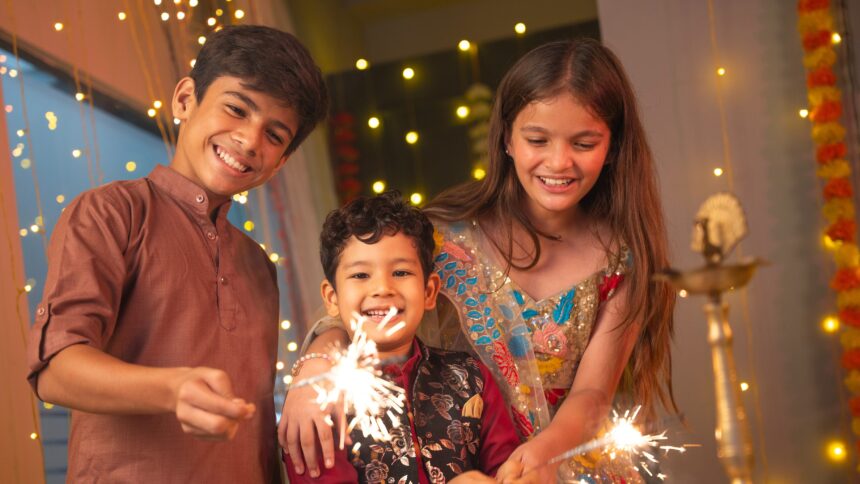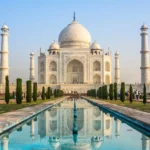Every year, India waits with anticipation for Diwali — the festival of lights. Homes are cleaned and decorated, sweets are prepared, lamps are lit, families gather from far and wide. In 2025, Diwali falls on Tuesday, 21 October. But like every Diwali, there’s much more than just a date.
This guide dives into why Diwali matters, how it’s celebrated across regions, its deeper meaning, and how you can make your Diwali 2025 unforgettable — meaningful, joyful, and responsible.
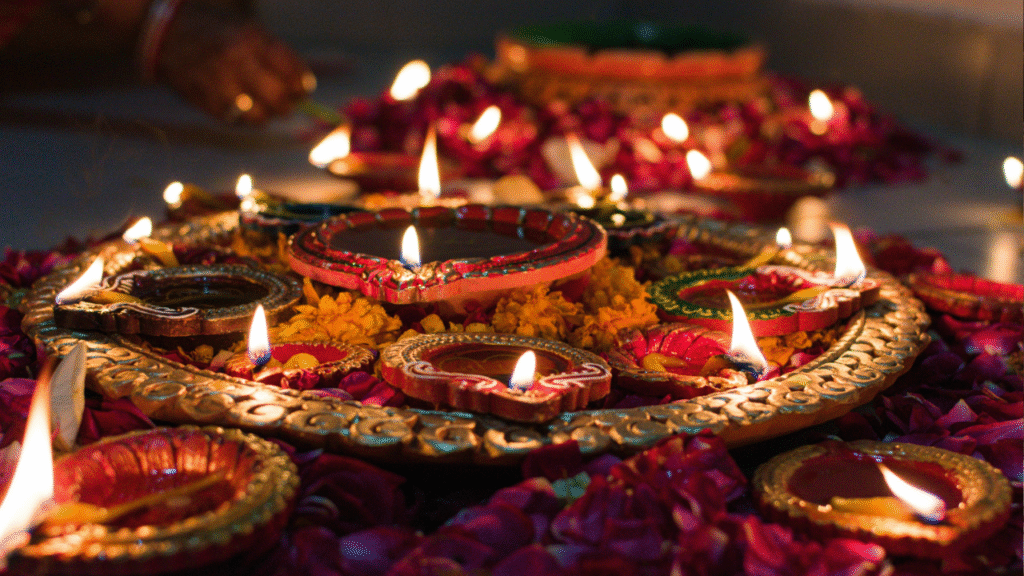
The Heart of Diwali: Why It Matters
Diwali isn’t just fireworks and sweets. It carries spiritual, cultural, and emotional weight.
- Victory of Light Over Darkness
At the core, Diwali reminds us that even after tough times, brightness returns. In texts, Lord Rama’s return from exile to Ayodhya after defeating Ravana is symbolic of good triumphing over evil. - Wealth, Prosperity & New Beginnings
Goddess Lakshmi is worshipped for prosperity; many start new financial ventures around Diwali. It’s also a time when people clean and renovate houses — a symbolic fresh start. - Family & Community
Diwali reunites families. Cities and villages alike share in the joy. Gifts, visits, meals — these deepen relationships. - Cultural Unity in Diversity
Though rooted in Hindu tradition, Diwali is observed by multiple religions:- Sikhs celebrate Bandi Chhor Divas
- Jains mark Mahavira’s Nirvana
- Some Buddhists observe reflections of light and kindness
This shared celebration showcases India’s pluralism.
- Reflection & Gratitude
Diwali is often used for introspection — forgiving wrongs, renewing bonds, giving thanks. Many people donate, help the poor, or commit to personal improvements.
When Is Diwali 2025? Calendar, Puja Muhurat & Key Days
To celebrate right, knowing the calendar, the best timing, and the sequence of days is essential.
- Main Diwali Day (Lakshmi Puja): Tuesday, 21 October 2025
- Amavasya (New Moon) Day: The day when the sky is moonless, significant because light (diyas) stands out.
- Muhurat for Lakshmi Puja: Evening slot when the puja holds strongest spiritual value. Usually in early evening to night.
Diwali unfolds over several days. Here’s a breakdown of what each day generally means:
| Day | Name | What’s Done | Significance |
| 1 | Dhanteras | Shopping of utensils, gold/silver, cleaning, lit lamps | Welcoming prosperity and health |
| 2 | Naraka Chaturdashi (Chhoti Diwali) | Early morning ritual baths, diyas in evening | Victory over darkness, evil |
| 3 | Lakshmi Puja (Main Diwali Day) | Lakshmi-Ganesha puja, lighting homes, sweets, fireworks | Blessings for wealth, happiness |
| 4 | Govardhan Puja / Annakut | Food offerings, worship of nature, gratitude | Recognition of nature’s bounty, divine protection |
| 5 | Bhai Dooj | Sisters invite brothers, tilak, feasts | Bond between siblings, goodwill |
Regions may vary or add local days, but this sequence is common.
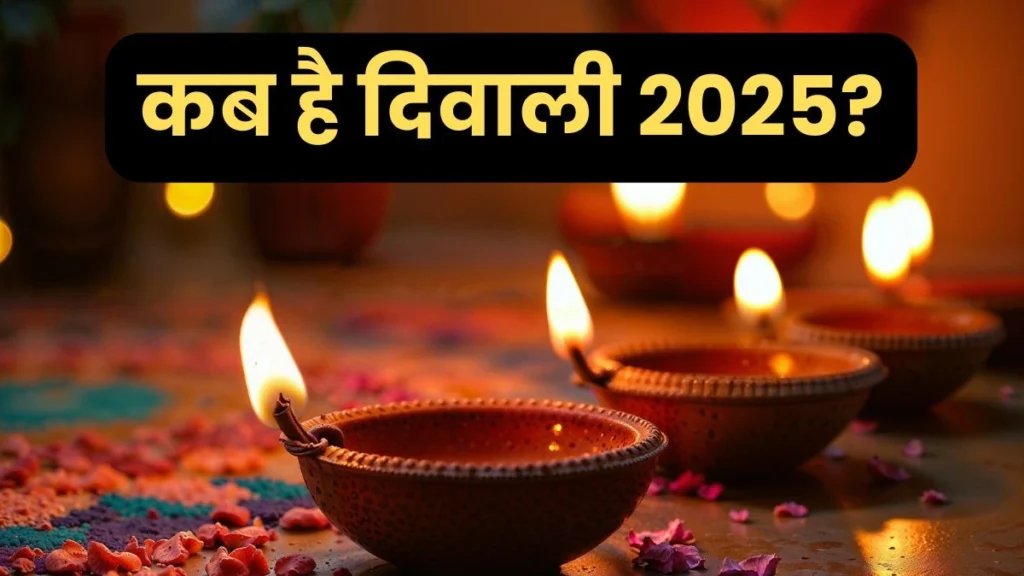
Rituals & Traditions: What You’ll See
From homes to marketplaces, these are the sights, sounds, and rituals that make Diwali alive.
- Cleaning and Decoration
Homes are scrubbed, walls painted, doors cleaned. Rangoli (colorful patterns) are drawn at entrances. Lamps and flowers adorn thresholds. - Lighting Lamps (Diyas)
Earthen lamps filled with oil or ghee, lit at dusk in windows, balconies, and the entrance. Symbolic of driving away ignorance and inviting light. - Lakshmi & Ganesha Puja
As Lakshmi brings wealth, Ganesha removes obstacles. Many households set up small altars, light incense, offer sweets, fruit, flowers, and chant prayers. - Sweets & New Clothes
Sweets are made at home or bought. Families dress in new traditional clothes. Sharing sweets/gifts with neighbors and relatives is common. - Fireworks & Crackers
Sound and light dominate the sky. Though increasingly regulated due to pollution, fireworks remain part of Diwali’s sparkle for many. - Charity & Giving
Many people give food, clothes, or money to those in need. It is considered auspicious to share your blessings.
Regional Variations: How Diwali Changes Across India
Though themes are common, the flavour of Diwali differs from state to state:
- North India (Uttar Pradesh, Delhi, Punjab)
Emphasis on Lakshmi puja, heavy sweets (mithai), loud crackers, colourful rangolis. - West India (Gujarat, Rajasthan, Maharashtra)
Business communities open new account books (Chopda Puja). Millets and regional snacks join the menu. - South India (Tamil Nadu, Karnataka, Andhra Pradesh)
Early morning rituals; homes decorated with mango leaves; lamps in courtyards; oil baths; some regions focus more on spiritual parts rather than fireworks. - East India (Bengal, Odisha, Assam)
Kali Puja is prominent. Midnight prayers. Sometimes multiple deities are worshipped. - North-East, Himalayan & Tribal Areas
Local customs, indigenous foods, fewer fireworks, often ecological sensitivity and focus on community feasts.
These variations make Diwali rich and dynamic.
History & Symbolism: Beyond the Sweets
Understanding how Diwali came to be helps deepen appreciation.
- Mythological Origins
Different myths contribute: Return of Rama, Krishna’s victory, Goddess Kali or Lakshmi worship, Mahavira’s enlightenment. These stories teach morals: right over wrong, knowledge over ignorance. - Agrarian & Seasonal Links
Diwali often coincides with harvest season in many regions. Celebrations mark the end of monsoon, thanking nature for harvest. - Cultural Evolution
Over centuries, Diwali absorbed regional beliefs, religious practices, trade influences (sweets, decor), arts (rangoli, lantern-making), making it inclusive. - Modern History
Under British rule, some restrictions were there; after independence, Diwali gained new freedoms. The festival became an expression of culture, unity, and hope in modern India.
Diwali 2025 Safety, Eco-Awareness & Modern Shifts
As India grows, so do concerns and responsibilities. Here are trends and best practices.
- Eco-friendly Diwali
Use clay lamps over plastic decor. LED lights. Green or low-smoke crackers. Less waste. Local artisans instead of mass-produced decor. - Reducing Pollution
Some states regulate cracker timings. Communities promote “quiet” or “green” fireworks. Awareness campaigns around air quality spikes. - Digital Celebrations
Virtual pujas for people far from home. Online gift shopping. DIY (do it yourself) decorations shared through social media. - Health Awareness
Mindful eating — maybe fewer sweets, more fruits. Keeping windows open when lighting crackers, care for pets, protect vulnerable people. - Supporting Local & Traditional Crafts
Buying handmade diyas, lanterns, sweets. Supporting weavers, pottery makers, small-scale food producers.
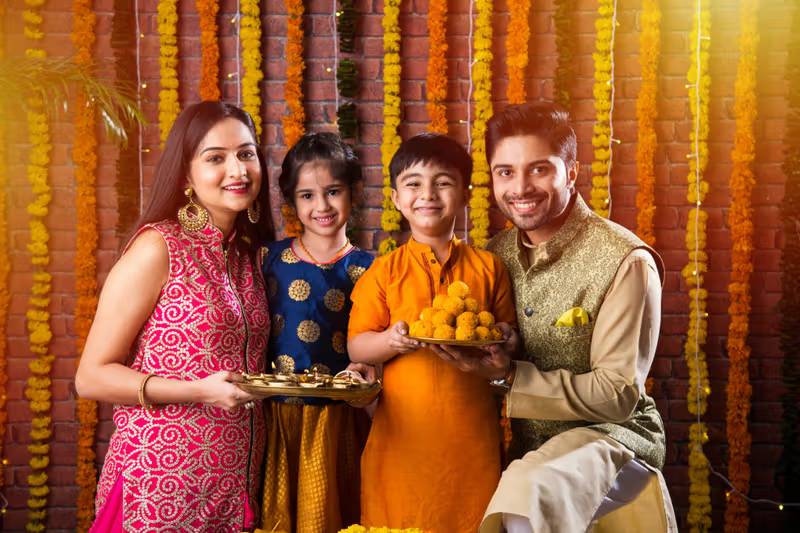
Real Stories from This Diwali Season
Storytelling brings traditions alive. Here are glimpses of how people are making Diwali 2025 personal.
- An Artisan from Jaipur
Rekha crafts clay diyas in her small workshop. This year she revives motifs from her grandmother’s designs, teaching younger women. She says, “light made by hand feels more meaningful.” - A Family in Mumbai
The Patels decide to downsize crackers to just sparklers for children. They focus instead on lighting, rangoli, gift-giving, and a big meal. “We feel more joy than smoke,” says Lakshmi Patel. - Village School in Kerala
A school teaches kids about energy efficiency; students make lanterns from recycled paper, plant saplings, and light lamps in school compound rather than fireworks. A tradition mixed with responsibility.
Puja Timings & Practical Guide
To worship in harmony, observing proper timings and planning helps.
- Best Time for Lakshmi Puja
Evening — after sunset, when dusk settles. It’s believed that during this period Goddess Lakshmi visits homes that are clean, lit, well prepared. - Puja Muhurat
Usually evening hours vary by city — around dusk to a few hours after. Check local timings for best accuracy. - Preparing the Puja Space
Clean the house. Decorate with rangoli. Use new cloth under deities. Arrange items neatly: idols, lamps, incense, sweets, flowers. - Puja Ritual Steps
- Invocation: Ganapati / Ganesha puja
- Lighting lamps and incense
- Offerings: sweets, fruits, flowers, coins
- Prayer / Mantra chanting
- Aarti (lamp-waving)
- Distribution of prasadam (blessed food)
- Managing Fireworks and Lighting Safely
Supervise children. Use safe zones. Have water buckets ready. Prefer low-smoke or green crackers.
How Diwali Reflects Modern India’s Values
Diwali 2025 isn’t just about tradition — it mirrors India’s present and future.
- Unity Across Diversity
The festival continues to bind people across castes, religions, states. Shared customs, shared food, shared light. - Sustainability & Conscious Choices
Rising awareness of climate issues pushes people to celebrate more responsibly. - Digital Connectivity
Even when physically apart, families connect via video calls. Social media shares, live streaming of pujas, gifting apps. - Supporting Local Economies
With Vocal for Local campaigns, many choose small craft makers, regional sweet makers, rural vendors. - Balance Between Tradition & Innovation
New sweets, fusion decor, LED lighting, modern design rangolis; yet the essence remains same: light, giving, hope.
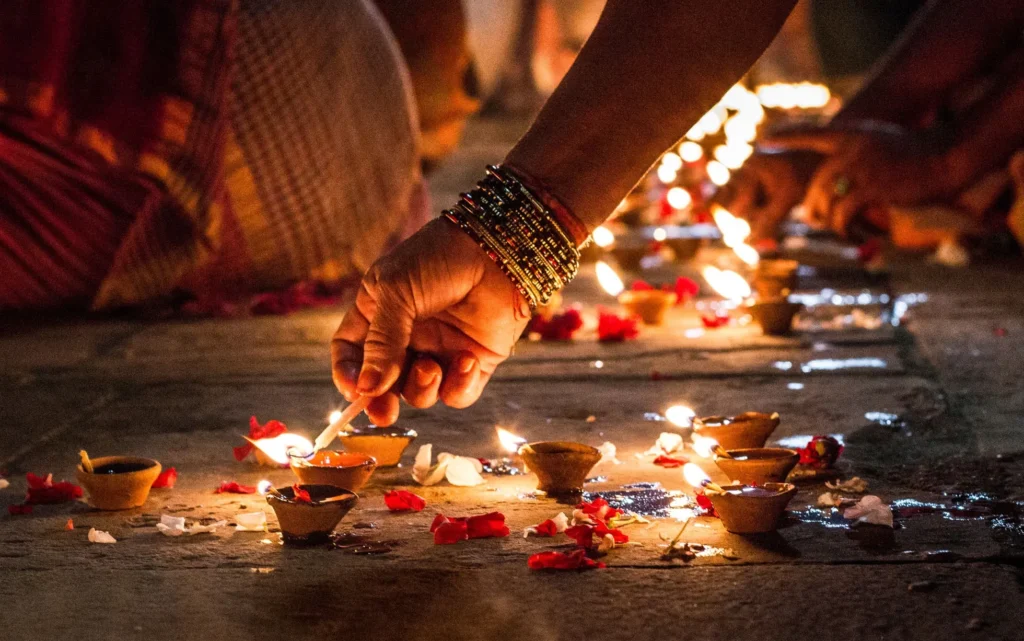
Tips to Celebrate Diwali 2025 with Joy & Meaning
Here are actionable ideas so your Diwali can be both festive and thoughtful:
- Plan ahead: clean house early to avoid last-minute rush.
- Incorporate millets or seasonal foods in your sweets or meals.
- Use reusable decorations, avoid excessive plastic.
- Choose eco lamps or diyas; collect used ones for reuse.
- Limit fireworks; pick safer options.
- Donate or help someone — it adds deeper joy.
- Teach children about what Diwali means: stories, rituals, caring.
- Share your celebration moments with kindness — hospitality, inclusion.
Reflection & Key Takeaways
Diwali 2025 is more than lights and sounds — it’s about remembering values that unite: light, hope, renewal, community.
- Celebrate with intention: meaning over excess.
- Honor tradition, but adapt to modern concerns (environment, health).
- Make Diwali inclusive — for those far from home, or less privileged.
- Let every diya, every rangoli, every prayer be an expression not just of celebration, but of shared humanity.
Beyond the lights and fireworks, Diwali is a celebration of human emotion — hope, gratitude, and renewal. Families reunite after months apart, neighbors exchange smiles, and even the simplest diya becomes a symbol of inner light defeating darkness. In a fast-changing India, Diwali remains a timeless reminder that happiness grows when shared.
Eco-friendly Diwali celebrations are becoming a national movement. Citizens are choosing clay diyas over plastic lights, planting trees instead of bursting crackers, and celebrating sustainability with pride. This change reflects India’s evolving mindset — balancing tradition with responsibility towards nature.

